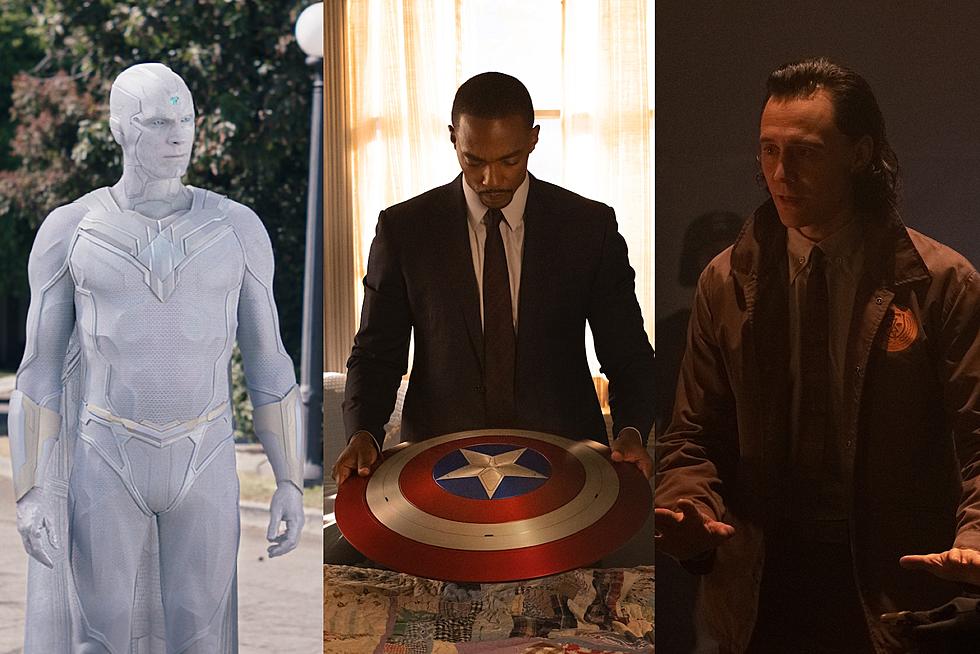![Praying For It: Chester Brown’s ‘Mary Wept Over The Feet of Jesus’ [Review]](http://townsquare.media/site/622/files/2016/04/MARYWEPT_cover300.jpg?w=630&h=1111&zc=1&s=0&a=t&q=89&w=980&q=75)
Praying For It: Chester Brown’s ‘Mary Wept Over The Feet of Jesus’ [Review]
They say that any joke you have to explain isn't a very good one. Chester Brown's latest work, the powerful and challenging Mary Wept Over the Feet of Jesus, is no joke, but he certainly feels the need to explain it. At great length.
First, there's the sub-title, which emphasizes subject matter that isn't terribly obvious in the comic itself --- Prostitution and Religious Obedience in the Bible --- and then there are the copious notes. The comics portion of the book is just 170 pages long, with two-to-four panels per page; the afterword, acknowledgments and notes are 100 more pages.
Does Brown's decision to over-explain his comic to a reader mean it isn't a very good one? No, not exactly, but it makes for an unusual, questionable reading experience, as a reader can feel Brown essentially looking over one's shoulder and explaining in one's ear while reading. And the sometimes defensive nature of Brown's amateur Bible scholarship and the leaps of logic taken to present a radical reading of the the extra-Biblical life of Mary, the mother of Jesus, and Jesus himself, look particularly suspect --- especially given Brown's own interest in prostitution. (His previous book was Paying For It: A Comic Strip Memoir About Being a John.)
That's a bias Brown himself notes in his afterword, but his scholarship more than his cartooning opens him up to the cynical reading that Mary Wept isn't just a reminder that Jesus was cool with prostitutes (and with not judging sinners in general), but that Brown wants to convince us that prostitution is a God-sanctioned, virtuous practice, rather than anything negative, or even neutral.
None of which is to suggest Mary Wept Over the Feet of Jesus isn't worth reading. This is the work of Chester Brown, the cartoonist responsible for Louis Riel, I Never Liked You and Ed The Happy Clown; someone whose every new work is always worthy of attention. It's also an excellently, even impeccably crafted comic, retelling of some of the oldest and most influential stories in our culture.
It's just that Brown is a better cartoonist than he is a religious writer.
There are ten stories adapted here, each presented as a chapter and named for their protagonists: Cain and Abel, Tamar, Rahab, Ruth and Bathsheba from the Old Testament, and Mary (the mother of Jesus), Mary of Bethany, and dramatizations of the parables of The Talents and The Prodigal Son from the New Testament, plus a completely invented story about Matthew, who Brown presents as the author of the gospel bearing his name.
An eleventh Bible story, an adaption of the story of Job, appears in the "Notes" section, and thus probably shouldn't be considered part of the graphic novel proper... though because the notes and afterword take up so many of the pages between the book's covers, perhaps we should question whether this is a graphic novel, or a hybrid work of comics and prose.
Of the Old Testament stories, the subject matter of most centers on the relationship between men and women, and some form of sexual contract. The standout is that of Cain and Abel, which has no women (Adam mentions their mother Eve a few times) and no sex.
Of the remaining five, the story of Mary is a composite of the annunciation story in two of the gospels, in which an angel tells the Virgin Mary that she is with child, and another angel tells Joseph to stay with her despite this. This is where Brown suggests his almost Da Vinci Code-like bombshell: Mary, the mother of Jesus, was a prostitute, he contends, and Jesus was conceived by one of her patrons. When the angel talks about the conception of Christ as being of the Holy Spirit, it is only in the manner that all conception is through the Holy Spirit.
In Brown's invented dialogue, Joseph even confronts her with the words, "I've been hearing rumours about you. Is it true that you've been accepting money from men and going to bed with them?"
Where did Brown get this idea? We'll return to that in a moment. Let's quickly run down the content of the rest of the stories. In the Parable of the Talents, Brown adds prostitutes where none were originally present. In Mary of Bethany he imagines the christening of Jesus as an off-panel sacred sex ritual with a prostitute ("Feet" was a euphemism for penis in Hebrew and, Brown suggests, maybe also in Aramaic, the language of Jesus; this is where the book gets its title). In Matthew, he has the gospel-writer fretting over how to secretly reveal to the world that Jesus' mother was a prostitute, and after meeting a young prostitute on a walk, he decides to hide the suggestion in a genealogy (Matthew, by the way, also patronized prostitutes, in Brown's story). The final story, presented out of order, is a version of The Prodigal Son parable, which involves the titular character blowing his inheritance on, among other things, prostitutes.
Alerted by the late Jane Schaberg's 1987 book The Illegitamacy of Jesus to the oddity of the gospel of Matthew naming five women in its genealogy --- rather than just the men --- Brown started to puzzle out why the author did this, and what the five women had in common. He determined that the only way to read Mary's inclusion given the stories of the others was that she must have been a prostitute.
Brown finds other supposed clues, enough to put forth the argument --- in the afterword and notes, not the comic --- but it amounts to only a possible, and not entirely probable, reading. I was personally distressed enough by his suggestion that the Gospel of Matthew was literally written by one guy named Matthew, and that the Book of Revelation was written by John of Patmos, which few serious scholars even consider, that I felt the need to take Brown's assertions with ever greater grains of salt.
He also reads the Prodigal son's message as that the father (God) loves the son "BECAUSE of what you did, not DESPITE it," which is where the big spender in the Parable of Talents and Abel getting rewarded for disobeying rather than obeying fits in to Brown's comics narrative. The subtitle mentions "religious obedience," after all, and repeatedly in these comics we see the disobedient being rewarded.
This is, as Brown notes from his cherry-picked stories, because God values disobedience and free will. God doesn't consider rules absolute, and places value on those who break them.
That may be a valid reading, particularly of some of those stories. But not of The Prodigal Son, in which the obedient son complains to his father that he threw such a big party for the return of the prodigal, who had squandered his inheritance. In the Gospel of Luke, the father responded: "Son, you are always with me, and what's mine is yours. It was fitting to celebrate and be glad, for your brother was dead and now he alive; he was lost, and is found."
Brown changes it to, "In his disobedience, your brother is alive. You, in your resentful subservicene, are dead. Do you think God wants mindless worshippers who can only follow instructions?"
A good point, certainly, but not that of the parable, which is one of a trilogy of "lost" parables, including that of the Lost Sheep and the Lost Coin. In all three cases, the reason to celebrate that which was lost was because it was returned and found after being lost, not because it was lost. (The coin and the lamb don't choose to go off, like the son does, as the son's father doesn't throw the party when he leaves, but only when he comes back.)
That is the story with which Brown concludes the comics portion of his argument, and it therefore falls apart.
The content in the notes may or may not be more compelling to various readers. Brown suggests that Jesus was pro-prostitute throughout his ministry because he was perhaps the son of one, but selectively chooses evidence to support the assertion. Jesus also hung out with tax-collectors, the poor and the sick, and sinners and undesirables of all sorts; he did so not because his mother was a poor, tax-collecting, prostituting leper, but because that was his ministry.
However one reads Brown's comic and his prose arguments and scholarship, those first 170-pages bear repeated readings. They are all good stories, some obviously more famous than others, and it is fascinating to enjoy Brown's telling of them, and to return to pick apart his storytelling choices, and to see how he meets traditional visual storytelling challenges like the depiction of God (a naked giant who walks the Earth with Adam, Cain and Abel, but whose face is turned away from the reader), Jesus (in silhouette or off-panel) and angels (the foot of a floating, off-panel man, a naked lady with wings).
Brown is a master storyteller, doing both what he does best --- telling stories --- and something apparently outside his comfort zone or area of expertise. Regardless of the outcome, we should hope that more cartoonists at the top of their game would challenge themselves thus, and produce more such challenging works.
More From ComicsAlliance
![All The Creator Spotlight Panels To Check Out At San Diego Comic Con [SDCC 2016]](http://townsquare.media/site/622/files/2016/07/Creator-Spotlight-Featured.png?w=980&q=75)

![‘The Playboy': Chester Brown’s Unflinching Autobiography of Sexual Awakening [Sex]](http://townsquare.media/site/622/files/2012/02/playboy-chester-brown.jpg?w=980&q=75)
![‘Fantastic Four’ #9 Recreated Page by Page with Indie Cartoonists [Art]](http://townsquare.media/site/622/files/2011/08/untitled-1-1314068971.jpg?w=980&q=75)





